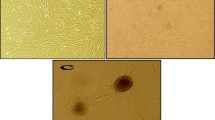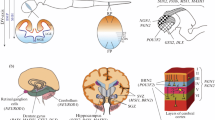Abstract
Human umbilical cord blood is an attractive source of stem cells; however, it has a heterogeneous cell population with few mesenchymal stem cells. Cell reprogramming induced by different methodologies can confer pluripotency to differentiated adult cells. The objective of this study was to evaluate the reprogramming of fibroblasts and their subsequent neural differentiation after co-culture with umbilical cord blood mononuclear cells. Cells were obtained from four human umbilical cords. The mononuclear cells were cultured for 7 d and subsequently co-cultured with mouse fibroblast NIH-3T3 cells for 6 d. The pluripotency of the cells was evaluated by RT-PCR using primers specific for pluripotency marker genes. The pluripotency was also confirmed by adipogenic and osteogenic differentiation. Neural differentiation of the reprogrammed cells was evaluated by immunofluorescence. All co-cultured cells showed adipogenic and osteogenic differentiation capacity. After co-cultivation, cells expressed the pluripotency gene KLF4. Statistically significant differences in cell area, diameter, optical density, and fractal dimension were observed by confocal microscopy in the neurally differentiated cells. Contact in the form of co-cultivation of fibroblasts with umbilical cord blood mononuclear fraction for 6 d promoted the reprogramming of these cells, allowing the later induction of neural differentiation.







Similar content being viewed by others
References
Al-Nbaheen M, Vishnubalaji R, Ali D, Bouslimi A, Al-Jassir F, Megges M, Prigione A., Adjaye J, Kassem M and Aldahmash A (2012). Human stromal (mesenchymal) stem cells from bone marrow, adipose tissue and skin exhibit differences in molecular phenotype and differentiation potential. Stem Cell Rev.
Ariel A, Serhan CN (2007) Resolvins and protectins in the termination program of acute inflammation. Trends Immunol 28:176–183
Baksh D, Song L, Tuan RS (2004) Adult mesenchymal stem cells: characterization, differentiation, and application in cell and gene therapy. J Cell Mol Med 8:301–316
Bieback K, Brinkmann I (2010) Mesenchymal stromal cells from human perinatal tissues: From biology to cell therapy. World J Stem Cells 2:81–92
Bocelli-Tyndall C, Barbero A, Candrian C, Ceredig R, Tyndall A, Martin I (2006) Human articular chondrocytes suppress in vitro proliferation of anti-CD3 activated peripheral blood mononuclear cells. J Cell Physiol 209:732–734
Bourillot PY, Aksoy I, Schreiber V, Wianny F, Schulz H, Hummel O, Hubner N, Savatier P (2009) Novel STAT3 target genes exert distinct roles in the inhibition of mesoderm and endoderm differentiation in cooperation with Nanog. Stem Cells 27:1760–1771
Bourillot PY, Savatier P (2010) Kruppel-like transcription factors and control of pluripotency. BMC Biol 8:125
Caplan AI, Dennis JE (2006) Mesenchymal stem cells as trophic mediators. J Cell Biochem 98:1076–1084
Carrino D, Gershman H (1977) Division of BALB/c mouse 3T3 and simian virus 40-transformed 3T3 cells in cellular aggregates. Proc Natl Acad Sci U S A 74:3874–3878
Cowan CA, Atienza J, Melton DA, Eggan K (2005) Nuclear reprogramming of somatic cells after fusion with human embryonic stem cells. Science 309:1369–1373
Desmouliere A, Darby IA, Gabbiani G (2003) Normal and pathologic soft tissue remodeling: role of the myofibroblast, with special emphasis on liver and kidney fibrosis. Lab Invest 83:1689–1707
Dominici M, Le Blanc K, Mueller I, Slaper-Cortenbach I, Marini F, Krause D, Deans R, Keating A, Prockop D, Horwitz E (2006) Minimal criteria for defining multipotent mesenchymal stromal cells. The International Society for Cellular Therapy position statement. Cytotherapy 8:315–317
Eldering JA, Felten C, Veilleux CA, Potts BJ (2004) Development of a PCR method for mycoplasma testing of Chinese hamster ovary cell cultures used in the manufacture of recombinant therapeutic proteins. Biologicals 32:183–193
Erices A, Conget P, Minguell JJ (2000) Mesenchymal progenitor cells in human umbilical cord blood. Br J Haematol 109:235–242
Evans MJ, Kaufman MH (1981) Establishment in culture of pluripotential cells from mouse embryos. Nature 292:154–156
Fries KM, Blieden T, Looney RJ, Sempowski GD, Silvera MR, Willis RA, Phipps RP (1994) Evidence of fibroblast heterogeneity and the role of fibroblast subpopulations in fibrosis. Clin Immunol Immunopathol 72:283–292
Haniffa MA, Collin MP, Buckley CD, Dazzi F (2009) Mesenchymal stem cells: the fibroblasts’ new clothes? Haematologica 94:258–263
Haniffa MA, Wang XN, Holtick U, Rae M, Isaacs JD, Dickinson AM, Hilkens CM, Collin MP (2007) Adult human fibroblasts are potent immunoregulatory cells and functionally equivalent to mesenchymal stem cells. J Immunol 179:1595–1604
Hardy RR, Wei CJ, Hayakawa K (2004) Selection during development of VH11+ B cells: a model for natural autoantibody-producing CD5+ B cells. Immunol Rev 197:60–74
Jiang J, Chan YS, Loh YH, Cai J, Tong GQ, Lim CA, Robson P, Zhong S, Ng HH (2008) A core Klf circuitry regulates self-renewal of embryonic stem cells. Nat Cell Biol 10:353–360
Jones S, Horwood N, Cope A, Dazzi F (2007) The antiproliferative effect of mesenchymal stem cells is a fundamental property shared by all stromal cells. J Immunol 179:2824–2831
Kobylka P, Ivanyi P, Breur-Vriesendorp BS (1998) Preservation of immunological and colony-forming capacities of long-term (15 years) cryopreserved cord blood cells. Transplantation 65:1275–1278
Korn JH (1981) Modulation of lymphocyte mitogen responses by cocultured fibroblasts. Cell Immunol 63:374–384
Le JM, Vilcek J (1987) Accessory function of human fibroblasts in mitogen-stimulated interferon-gamma production by T lymphocytes. Inhibition by interleukin 1 and tumor necrosis factor. J Immunol 139:3330–3337
Mareschi K, Biasin E, Piacibello W, Aglietta M, Madon E, Fagioli F (2001) Isolation of human mesenchymal stem cells: bone marrow versus umbilical cord blood. Haematologica 86:1099–1100
Martin GR (1981) Isolation of a pluripotent cell line from early mouse embryos cultured in medium conditioned by teratocarcinoma stem cells. Proc Natl Acad Sci U S A 78:7634–7638
Meirelles Lda S, Fontes AM, Covas DT, Caplan AI (2009) Mechanisms involved in the therapeutic properties of mesenchymal stem cells. Cytokine Growth Factor Rev 20:419–427
Momin EN, Mohyeldin A, Zaidi HA, Vela G, Quinones-Hinojosa A (2010) Mesenchymal stem cells: new approaches for the treatment of neurological diseases. Curr Stem Cell Res Ther 5:326–344
Phinney DG, Kopen G, Isaacson RL, Prockop DJ (1999) Plastic adherent stromal cells from the bone marrow of commonly used strains of inbred mice: variations in yield, growth, and differentiation. J Cell Biochem 72:570–585
Rossi DJ, Bryder D, Zahn JM, Ahlenius H, Sonu R, Wagers AJ, Weissman IL (2005) Cell intrinsic alterations underlie hematopoietic stem cell aging. Proc Natl Acad Sci U S A 102:9194–9199
Sarkhosh K, Tredget EE, Li Y, Kilani RT, Uludag H, Ghahary A (2003) Proliferation of peripheral blood mononuclear cells is suppressed by the indoleamine 2,3-dioxygenase expression of interferon-gamma-treated skin cells in a co-culture system. Wound Repair Regen 11:337–345
Serhan CN, Brain SD, Buckley CD, Gilroy DW, Haslett C, O’Neill LA, Perretti M, Rossi AG, Wallace JL (2007) Resolution of inflammation: state of the art, definitions and terms. FASEB J 21:325–332
Song S, Sanchez-Ramos J (2008) Preparation of neural progenitors from bone marrow and umbilical cord blood. Methods Mol Biol 438:123–134
Steinberg S, Katsanis S, Moser A, Cutting G (2005) Biochemical analysis of cultured chorionic villi for the prenatal diagnosis of peroxisomal disorders: biochemical thresholds and molecular sensitivity for maternal cell contamination detection. J Med Genet 42:38–44
Tada M, Takahama Y, Abe K, Nakatsuji N, Tada T (2001) Nuclear reprogramming of somatic cells by in vitro hybridization with ES cells. Curr Biol 11:1553–1558
Takahashi K, Yamanaka S (2006) Induction of pluripotent stem cells from mouse embryonic and adult fibroblast cultures by defined factors. Cell 126:663–676
Thomson JA, Itskovitz-Eldor J, Shapiro SS, Waknitz MA, Swiergiel JJ, Marshall VS, Jones JM (1998) Embryonic stem cell lines derived from human blastocysts. Science 282:1145–1147
Volokhov DV, Kong H, George J, Anderson C, Chizhikov VE (2008) Biological enrichment of Mycoplasma agents by cocultivation with permissive cell cultures. Appl Environ Microbiol 74:5383–5391
Wagner J, Kean T, Young R, Dennis JE, Caplan AI (2009) Optimizing mesenchymal stem cell-based therapeutics. Curr Opin Biotechnol 20:531–536
Wang H, Kong F, Jelfs P, James G, Gilbert GL (2004) Simultaneous detection and identification of common cell culture contaminant and pathogenic mollicutes strains by reverse line blot hybridization. Appl Environ Microbiol 70:1483–1486
Wilkins A, Kemp K, Ginty M, Hares K, Mallam E, Scolding N (2009) Human bone marrow-derived mesenchymal stem cells secrete brain-derived neurotrophic factor which promotes neuronal survival in vitro. Stem Cell Res 3:63–70
Wilmut I, Schnieke AE, McWhir J, Kind AJ, Campbell KH (1997) Viable offspring derived from fetal and adult mammalian cells. Nature 385:810–813
Financial support
CNPQ—Counsel of Technological and Scientific Development (Conselho Nacional de Desenvolvimento Científico e Tecnológico), Brazil
CCB—Cryogenesis Brazil Center (Centro de Criogenia Brasil), Brazil.
Author information
Authors and Affiliations
Corresponding author
Additional information
Editor: T. Okamoto
Rights and permissions
About this article
Cite this article
Marinowic, D.R., Domingues, M.F., Machado, D.C. et al. The expression of pluripotency genes and neuronal markers after neurodifferentiation in fibroblasts co-cultured with human umbilical cord blood mononuclear cells. In Vitro Cell.Dev.Biol.-Animal 51, 26–35 (2015). https://doi.org/10.1007/s11626-014-9804-8
Received:
Accepted:
Published:
Issue Date:
DOI: https://doi.org/10.1007/s11626-014-9804-8




